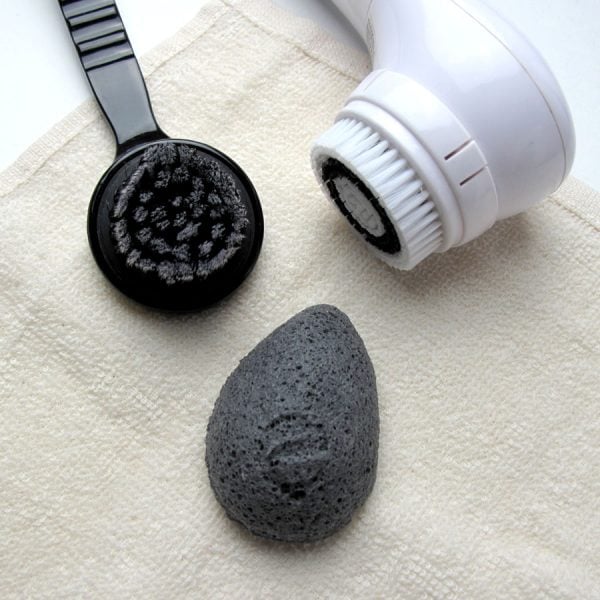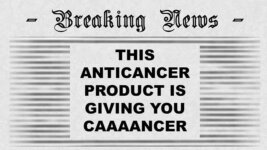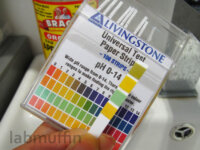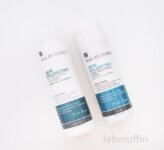Exfoliants are one of the first products you start using when you get into REAL skincare. They’re a really great gateway product, but they can be a bit confusing and there are loads of myths about them. So today I’m doing the debunking!
(More info on exfoliants in my Essential guide, in case you haven’t downloaded it yet!)
The YouTube video is here, keep scrolling for the written version…
Myth 1: “Stronger exfoliants are better”
When you start using chemical exfoliants, it’s really tempting to just go for the strongest exfoliant you can find. 10% lactic acid is only 30 cents more than 5% lactic acid, you’re getting DOUBLE the exfoliation for just a tiny bit more, you’d be stupid not to get the stronger one! That’s like half the price per percent!

The problem here is… OVEREXFOLIATION.
First off, chemical exfoliants are great but a lot of them need a low pH to work – that means they’re acidic (which is probably not a huge surprise if you’ve read the label). Your skin is acidic, but it’s not THAT acidic. Low pH means potential chemical burns.
Even if you have an exfoliant that’s not at a low pH, it’s still an issue because it’s an exfoliant. Exfoliants exfoliate, meaning that they thin the stratum corneum, the layer of dead skin cells on the surface of your skin. This is why you end up with smooth, glowing skin when you use exfoliants – they’re getting rid of excess dead cells on the surface.
But you still need some dead skin cells! That layer is there for a reason. It’s important for helping your skin act as a barrier. This barrier keeps water in, so your skin stays hydrated, and keeps irritants out.
If you overexfoliate, you’re making this layer too thin. It’s like you’re sandpapering your face too much, or dissolving too much of your skin.
That means that your skin is going to be more prone to getting dehydrated, and you can make your skin more sensitive. Your skin might go red and tight, products that don’t usually sting might start stinging, you can get more breakouts… it’s a whole mess.
And even worse, it takes ages to resolve itself. You might have to baby your skin for weeks before it recovers! It’s much better to not do this in the first place.
To stop yourself from overexfoliating… unfortunately you have to have self-control and go slowly and listen to your skin.
- Start with a lower percentage product and slowly increase the strength
- Slowly ramp up how often you use your exfoliant
- If your skin starts showing any signs of overexfoliation, back off and use a weaker product, or even no product at all, until your skin recovers
That means that lower percentage products have a place – an important place – in your routine. So don’t just go for the strongest thing you can!
Myth 2: “You can’t use chemical exfoliants in the morning”
This myth comes from the fact that glycolic acid makes your skin photosensitive, so it takes less sunlight to burn or tan. Since alpha hydroxy acid exfoliants all work the same way, this probably applies to other ones like lactic acid as well.
But the way that alpha hydroxy acids cause photosensitivity isn’t by interacting with sunlight. It’s that they’ve changed your skin structure to make it more sun sensitive, then your sensitive skin goes under sunlight. It doesn’t matter whether or not the acid is still on your skin!
This effect can last for over a week after you’ve stopped using the exfoliant, so it doesn’t matter if you use it morning or night: your skin is still more likely to get sun damage.
Related post: Do I need extra sunscreen when using chemical exfoliants?
So the bottom line is: You can use chemical exfoliants any time you like – but you should always use a sunscreen if you’ve used a chemical exfoliant in the past week (you should be using a sunscreen anyway).
Myth 3: “Physical exfoliants aren’t good for your skin”
There’s this idea in some parts of the internet that physical exfoliants are basically the devil, and you should only use chemical exfoliants.
This is just not true. Physical exfoliation in the right hands works really well. Microdermabrasion, for example, is used by dermatologists and skin therapists to treat photoaging, uneven skin texture and acne scarring.
The issue is that some physical exfoliants are really easy to overuse, and some of them encourage you to overuse them, and the scrubbing feeling is sort of satisfying in the “if it hurts then it must be working” sort of way. So if you’re new to skincare, not really sure of what you’re doing and don’t know how to listen to your skin, you can end up in overexfoliation territory very easily.
And a lot of strong physical exfoliants – harsh scrubs, cleansing brushes – are really accessible to people who are new to skincare. When people initially stop using those products, their skin improves so it looks like those products are bad.
But that doesn’t mean that people who are more experienced can’t use them effectively later on! There are also lots of really gentle physical exfoliants like konjac sponges and peeling gels that are less well-known.
There’s also one big advantage that physical exfoliants have over chemical exfoliants – because they work straight away, it’s much easier to tell if you’ve overexfoliated so you can stop, instead of finding out a day later when you wake up with a raw face.
Also there’s no good evidence that physical exfoliants cause microtears or that those microtears will make your skin more prone to infections. Overexfoliation will make your skin more prone to infections because your barrier’s a bit crap, but that happens with chemical exfoliants too.
Myth 4: “People with dark skin can’t use glycolic acid exfoliants”
There are quite a lot of studies where high percentage glycolic acid peels were used on people with darker skin that had good results in fading pigment. For example:
- 35% glycolic acid alone or in combination with a 10% or 20% TCA spot peel for melasma in Fitzpatrick types III-V (90% of patients were IV and V)
- 70% glycolic acid for treating melasma in dark skinned patients (Fitzpatrick III-V)
- 30% glycolic acid + 20% azelaic acid for treating melasma in Fitzpatrick types IV and V
- 50% glycolic acid peels monthly (this one specifically looked at the safety of this protocol on Indian women and found “hardly any side effects”)
There’s more information on the strength of evidence for glycolic acid peels for treating melasma in dark skin in this open-access review too. These studies used high percentage peels, so with a much lower percentage chemical exfoliant you’d expect less side effects.
I think where this myth comes from two places:
Chemical peels can have hyperpigmentation as a side effect if they’re left on for too long, or if too high a strength is used, and people with darker skin are more prone to hyperpigmentation. That’s one of the reasons why doing a chemical peel at home is risky, and it’s safer to go to someone who knows how to avoid these issues.
Glycolic acid is a small molecule, so it can get deeper into your skin. That means that the risk of side effects is higher than with lactic acid or mandelic acid, if everything else in the product is the same.
But there are tons of other things in an AHA product that will change how strong it is – the most important ones are percentage and pH.
Related post: Video: Why pH matters for AHAs and acids in skincare
So a 5% glycolic acid product at pH 3 is going to be less risky than a 40% lactic acid peel at pH 2. A 40% glycolic acid peel at pH 2 might be riskier than that lactic acid peel, but as we can see from the scientific evidence, and from the dermatologists and estheticians who use peels on dark skin all the time, both can be used safely in the right hands.
Myth 5: “You can’t use chemical exfoliants at the same time as a retinoid”
There’s no rule that you can’t use chemical exfoliants at the same time as a retinoid – they won’t cancel each other out, or react with each other dangerously or anything like that.
Some retinoids do tend to work better at a higher pH than chemical exfoliants, but you don’t need to worry too much about this because pH isn’t as much of an issue once the product’s on your skin and absorbed (if you’re worried, you can wait a few minutes between them).
There is a potential issue though: both are really irritating, so it’s possible that your skin can’t handle both at the same time without getting irritated and angry and overexfoliated. So it’s a good idea to start slowly with gentle products and add one in at a time, and monitor your skin carefully while you’re using them.
More on exfoliation: The Essential Guide to Exfoliation
References
Kornhauser A et al., The effects of topically applied glycolic acid and salicylic acid on ultraviolet radiation-induced erythema, DNA damage and sunburn cell formation in human skin (open access), J Dermatol Sci 2009, 55, 10-17. DOI: 10.1016/j.jdermsci.2009.03.011
Shah M & Crane JS, Microdermabrasion (open access) (updated 2020 May 4), in StatPearls
Garg S et al., Comparative efficacy of a 35% glycolic acid peel alone or in combination with a 10% and 20% trichloroacetic acid spot peel for melasma: a randomized control trial, Dermatol Surg 2019, 45, 1394-1400. DOI: 55, 10-17. DOI: 10.1097/DSS.0000000000001964
Khunger N et al., Tretinoin peels versus glycolic acid peels in the treatment of melasma in dark-skinned patients, Dermatol Surg 2004, 30, 756-760. DOI: 10.1111/j.1524-4725.2004.30212.x
Dayal S, Sahu P & Dua R, Combination of glycolic acid peel and topical 20% azelaic acid cream in melasma patients: efficacy and improvement in quality of life, J Cosmet Dermatol 2017, 16, 35-42. DOI: 55, 10-17. DOI: 10.1111/jocd.12260
Javaheri SM et al., Safety and efficacy of glycolic acid facial peel in Indian women with melasma, Int J Dermatol 2001, 40, 354-357. DOI: 55, 10-17. DOI: 10.1046/j.1365-4362.2001.01149.x
Sarkar R, Bansal S & Garg VK, Chemical peels for melasma in dark-skinned patients (open access), J Cutan Aesthet Surg 2012, 5, 247-253. DOI: 55, 10-17. DOI: 10.4103/0974-2077.104912








Hi Michelle,
Thanks for your post. Unfortunately this has come too late for me. I over exfoliated a few weeks ago, and I’m still suffering from breakouts as a result. My question is, when can I start exfoliating again? I’m stuck wondering whether my impaired barrier is causing my breakouts, or if not exfoliating is causing my breakouts 😢
Omg thank you for this! I’ve heard sooo much by skincare youtube how bad physical exfoliants are so I basically threw all of mine out. I’m glad to hear that they’re not actually that bad in moderation!
Can you look into best practices and products for people with rosacea ?
I like to use Gluconalactone and Acetyl Glucosamine every day, prior to my vitamin c in the morning and retinol with niacinamide ( skinmedica ) in the evening and just once time per week a stronger AHA. The results on my hyperpigmentation are amazing. It took like 4 months untill I saw the improvement but they are almost gone. My skin barrier has improved greatly and my texture and wrinkles also.
PHA are my hero.
What would you recommend for getting rid of blackheads? I tried a 2% salicylic acid face wash with pH 5. It makes a slight short-lived difference. I’m based in Europe.
What about azelaic acid? I see it usually recommended for daily use, would that lead to overxfoliation as well? Can it be used together with retinol (in separate routines, azelaic in the morning and retinol at night)?
Hi Michelle,
I spend a lot of time in the ocean doing water sports and its hard not to burn..im wondering if it would be best to eliminate exfoliating acids..
Im having a hard time with finding a good sport sunscreen for my face too.
Thanks for all you do